Can Ducati improve on greatness once again in the high-paced world of superbikes? You betcha! We take the 2009 model 1198S for its first fang on the Aussie roads.
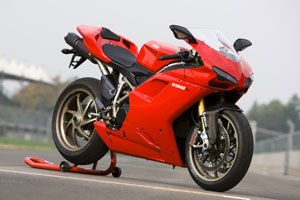
SPECIFICATIONS
ENGINE
Engine type: L-Twin cylinder, 4 valve per cylinder Desmodromic, liquid cooled
Bore x stroke: 106×67.9mm
Displacement: 1198.4cc
Compression ratio: 12.7:1
Transmission: Six speed
Power (claimed): 170hp @ 9750rpm
Torque (claimed): 97ft-lbs @ 8000rpm
CHASSIS
Frame type: Tubular steel Trellis
Front suspension: Öhlins 43mm fully adjustable upside-down fork with TiN
Rear suspension: Progressive linkage with fully adjustable Öhlins monoshock with top-out spring. Aluminium single-sided swingarm
Wheels (front/rear): “GP Replica” 7-spoke in forged light alloy 3.50 x 17 / “GP Replica” 7-spoke forged light alloy 6.00 x 17
Tyres (front/rear): 120/70 ZR17 / 190/55 ZR17
Brakes (front/rear): Twin 330mm semi-floating discs, radially-mounted Brembo Monobloc four-piston calipers / 245mm disc, two-piston caliper
DIMENSIONS
Weight (claimed): 169kg
Wheelbase: 1430mm
Seat height: 820mm
Fuel capacity: 15.5L (of which 4L reserve)
PURCHASE DETAILS
Price: $33,990 + orc
Colour options: Red or Midnight Black
Test bike from: Ducati Australia – www.ducati.com.au
It seems like just months ago that I was at Eastern Creek anticipating the first local ride of the 1098, but in reality it’s been over two years since that memorable day in which we sampled Ducati’s latest superbike weaponry for the first time.
Since then we’ve seen the 1098 range win numerous awards throughout the media and on the race track, with Aussies Troy Bayliss and Brendan Roberts even becoming world champions on it in both Superbike and Superstock respectively.
But already we’ve got an evolution of one of the most successful bikes that Ducati has ever produced, with the 1198 range featuring a standard model and an up-spec S model, which is the exact bike that we’ve managed to get out hands on.
It’s safe to say that Ducati’s latest superbike line-up, along with the earthmoving Desmosedici RR and an array of impressive naked bikes, has boosted Ducat back into being recognised as the manufacturers of some of the highest performing and beautiful motorcycles available on the market.
Our first attempt to test the 1198 model was at Eastern Creek’s official local launch for the bike, but that was washed away (literally) by a gloomy day that saw rain fall for the entire test, effectively putting an end to our chances of swinging a leg over the bike at all.
A few weeks later and I find myself armed with an 1198S of my own with no other journalists to share it with, allowing me to get a solid test ride in with no interruptions whatsoever.
The only downfall is that there aren’t any ride days that fall in the time frame that I’ve got the test bike for, meaning that my chances of testing the DTC (Ducati Traction Control) system are slim to none in the real world as you just can’t push it as hard as what you can on the race track.
But right away at first acceleration I can feel the increase in torque and power of the high engine capacity, with the 1198 continuously blowing me away with every twist of the throttle applied around the streets.
With an extra 10 horsepower on tap and even more torque than that of the 1098, you could say that it’s got more than needed for the public roads, but it’s the smooth range of power throughout that grabs your attention from the get go.
I don’t usually write about an engine first in many of my tests, but you simply can’t look past the twin-cylinder powerhouse that the boys from Bologna have developed, with power almost anywhere you like in the engine.
Beginning to pull from 4000rpm, gaining steam at 6000rpm, and really accelerating hard at 8000rpm, the delivery is consistent as the revs increase, although you do have to be smooth on initial acceleration in low gears as that torque does hit hard from the bottom.
From those low rpm levels all the way to where the engine makes maximum power at 9500rpm, I can tell you that you hit triple digit speeds before you know it.
I never do get to actually rev it to redline point though, because my speed would see me locked up in jail with the key thrown away, but the dash reads a maximum of 13,000rpm.
The responsiveness of the engine is incredible, even for a bike that was very new with minimal kilometres on it direct from Ducati’s brand new press fleet.
In traffic and when taking off from lights I feel like it lags a little at extremely low revs before chugging away, but I soon realise that the best way to go about it is to let the clutch out quickly and let the engine do the work. Dragging the clutch isn’t the way to go.
What really blows me away with the 1198 is the smooth function of the gearbox when tapping through the gears. Both up and down shifting are phenomenal, instantly attracting my attention.
Pivot your foot up against the gear lever and it’ll shift up to the next gear without any sign of notching or difficulty, also performing in the same capable trend when working your way back down through the ’box into the turns.
Many have questioned Ducati for not fitting the 1198 or 1198S with a slipper-clutch, as fitted standard on the 1098R, although on the road I really can’t feel the need for it since the engine freewheels into the corners without any hint of trying to lock the rear wheel under braking.
Speaking of cornering, you could say that commitment is the first priority if you’re going to be a Ducati rider, because like most high class performance bikes, the harder you ride it the better it will react – seriously.
Nursing it into a corner and idling through before you walk it out is the wrong way to go on the 1198. You need to show it who’s boss, muscle it into the turns, and get hard on the gas on exit – grinning all the way until the next braking point.
It is then that you will be able to take advantage of features such as the DTC, which elevates the top of the line Ducati superbikes into a whole new world above any production sportsbike on the market.
In the real world I’m not afraid that admit that I don’t see the lights flash on the dash to indicate the DTC kicking in at all, and I never really got on the gas hard enough to actually put the system to use – not that I know of anyway! Maybe it was that good?
To really ride any bike hard you have to at least gain confidence first, and in order to get confident, you realistically need to be comfortable on the bike and get a good feel for all functions and controls – which are exceptional quality, as expected.
With a seat height 10mm taller than the Suzuki GSX-R1000 that we tested last issue (820mm to 810mm), the Ducati isn’t exactly a tall bike, but it is in the taller end of the sportsbike market.
Just like the 1098, it pitches you forward with a lot of weight on the wrists, although the reach to the handlebars from the fuel tank is actually quite short. There is a massive amount of seat room and if I slid all the way back I actually couldn’t even reach the ’bars, so that bodes well for the taller riders out there.
The seat is hard and isn’t the most forgiving, but you’d have to expect that when purchasing a Ducati superbike – they are race bred through and through. It’s not exactly designed for touring, but Ducati’s impressive accessories list does make it a much more realistic option to pack gear onboard if you’re that keen.
One particular thing that bugs me about the Ducati is when you do a sharp turn, which you do many of on a photo shoot, it crunches your outside hand between the fairing and handlebar when on full lock.
It’s not a massive problem because on normal occasions you wouldn’t be doing U-turns repeatedly, but it is a nuisance that makes it tricky at times if you’re on a sloped stretch of road, or in a particularly tight spot.
As noted in the sidebar about the dash, it’s kind of like operating a space shuttle there are so many options.
It’s all hand operated via buttons on the ’bars and is actually pretty simple to use once you get your head around it. The larger numbers on the 1198 makes it much better to read and easier on the eyes at speed than what the 1098 dash ever was, so props to Ducati for listening to many people’s requests.
The automatic brightness of the LED backlighting on the dash is a very handy tool, which got brighter and brighter as the sun went down on the ride home from our photo shoot, and again when storm clouds hovered over me on the trip back to Ducati.
While you’ve got an extremely nice sight when glancing down at the dash, checking out what’s behind you isn’t so easy as the mirrors are just as difficult to see out of as the 1098.
Ducati now has 30mm extension kits that come with the bike tough, and they help slightly. The only problem is that on medium revs the vibrations affect the rear view, especially on freeways when you’re cruising at a speed where there’s only a low percentage of throttle required.
As mentioned earlier, shifting down into the corners is sensational, which triggers a smooth transition into the turns and allows you to really point the bike where you want it to go. Again, you need to put it where you want, because it doesn’t react as well to gentle riding.
Helping you get aggressive on the Ducati is the touchy Brembo front braking system, with the Monobloc calipers proving as powerful as on previous models where you really only require a finger or two to pull it up in a hurry.
The back brake is just as useful and works a little too good at times, although as a rider who drags the rear brake a bit I often do find the Brembo rear fading quicker than what I do on the Japanese sportsbikes.
Once turned it holds its line good with a significant amount of weight over the front wheel and tyre, only getting upset by the sharpest of bumps after it breezes through many ripples and soaks them up with the quality suspension.
Stability mid-turn is arguably the Ducati’s strongest point, because on a long flowing turn, once you’re at a medium lean angle, you really can’t fault it as it tracts around the corner and the engine only highlights the experience.
Pirelli’s Diablo Supercorsa SP tyres also assist in the sharp handling of the 1198S, heating up quickly and providing a lot of grip no matter how fast you’re going on the street. They’re also very good on the track from my past experiences.
But I wouldn’t like to get caught out on a rainy day with these tyres on, because to be honest they really don’t have many more groves in them than the Pirelli slicks that are used as the control tyres in world Superbike.
Following a limited amount of time in the saddle of the 1198S it must be said that the improved engine has made a wonderful step forward overall. The package is mightily improved, with slight touches such as the larger numbers on the dash or the mirror extensions that are now provided only making the bike better again.
It can be yours for $33,990 + orc, which is a couple of grand more than what you could buy the 1098S for last year, but with the DTC system added to the bike for this year there’s simply no comparison in their overall performance.
Yee-ha! Ducati has come up with the good once again, but did we really expect anything less? Not at all.
TECHNICAL INFORMATION
POWERPLANT
The new liquid-cooled, DOHC, desmodromic, eight-valve, 90-degree, L-shaped twin-cylinder engine bolted into the 1198S is the major difference between the new model and the previous 1098 range, situating itself in between the former 1098S model and the range-leading 1098R.
Featuring an increased capacity of 1198.4cc over the previous S model’s 1099cc, it’s that capacity that has set the new bike alight thanks to a new bore and stroke of 106 x 67.9mm – which are the same dimensions as what Troy Bayliss’ 1098R used in World SBK last year.
Also changed in the engine are the valves at 43.5mm for the inlet and 35.5 for the exhaust, which are four percent bigger than on the 1098.
The pistons are now the same as those found inside the 1098R engine, and the gearbox has the same ratios as that of the 1098R, although there are wider teeth fitted to accommodate the torque.
Comparing the gears on the 1198 to the 1098, third through sixth gear are taller, while the first and second gears remain the same as what is used in the 1098 gearbox.
The throttle bodies are now 63.9mm in diameter, which is the same as the 1098R and bigger compared to the 1098S’s size of 60mm.
Crankcases are now made up from a vacuum die-cast process that makes them stronger even though they are thinner, resulting in a lighter weight and stronger build quality. The cam covers are also now magnesium alloy.
It’s these changes that make the Testastretta Evoluzione engine the lightest ever that has been used in a Ducati superbike.
All of these changes equal a 10 horsepower increase in engine power (up to 170hp at 9500rpm), while torque is boosted up to a whopping 97ft-lbs at 8000rpm according to Ducati’s press kit.
FRAME WORK
We won’t hold it against you if you’ve been staring at this article thinking that the 1198 is simply a 1098 with new decals. In all honesty it does look very much similar, but as the engine breakout reveals, it’s a whole new beast beneath the flesh.
As far as the chassis and running gear goes it is actually very much the same proven equipment that’s been tried and tested over the previous two years on the 1098, with the tubular steel trellis continuing Ducati’s tradition.
The 1198S model that we are testing features 43mm fully-adjustable Öhlins forks in the front complete with titanium nitride-treated sliders, and a fully-adjustable Öhlins shock absorber in the rear to make up a first class suspension package.
An Öhlins steering damper is also included in the package on all of the Ducati superbike models.
Braking is powered by Brembo four-piston Monobloc calipers clamped to 330mm discs at the front, with a single 245mm disc and Brembo twin-piston caliper at the back.
New for the 1198S are the seven spoke forged alloy Marchesini wheels, which are inspired from MotoGP, as many things on the latest and greatest sportsbikes happen to be in this day and age.
Assisting in an overall weight reduction of three kilograms on the 1198S is a lighter headlight/fairing mount, which sheds half a kilo off the weight in itself now that it’s made out of cast magnesium instead of cast aluminium.
One part of the 1198 range that is a great improvement is the MotoGP-inspired Digitek dash, which is operated from the left handlebar and features a range of options including a digital readout for speed, rpm, a lap timer, clock, air and engine temperatures, battery voltage, a pair of trip metres, a fuel reserve trip metre, scheduled maintenance, and all the warning and indicator lights.
When activated, the instrument panel also displays the DDA and DTC systems, including what level DTC you are on and how much it’s kicking in (see DTC breakout for further details).
This year’s model features bigger numbers than in years past so it’s easier to read, and the addition of bright white LED backlighting that automatically adjusts dependant of the lighting conditions that you’re riding in.
The overall dry weight of the 1198S is 169kg, which is down three from the 1098S.
Colour options for this year’s S model are Red or Midnight Black, while the wheels on the S are now bronze.
DTC AND DDA
Two of the most revolutionary assets of Ducati’s superbike range is the addition of the Ducati Traction Control system and the Ducati Data Analyser, both of which were introduced back when the 1098 range was originally launched in 2007.
In previous years the DTC system was only available on the 1098R and could only be switched on when using track-spec exhaust pipes, but for this year the 1198S comes with DTC and is an updated version that works with the standard exhausts (as does the new 1098R).
While the last system only cut the ignition and let unburnt fuel pump through to the exhaust (which is why it couldn’t be used with the standard exhaust and catalyser), the new DTC system also cuts fuel flow.
Using sensors on both the front and rear wheels, the DTC system again has eight levels, with one being the lowest setting and eight causing the TC to kick in more than the rest.
There are lights on the dash that indicate when the DTC is working, with one small light showing a reduction in spark, two meaning more, and three indicating a big reduction in spark. After that there’s a bigger red light that will illuminate, which means that the system is now also cutting fuel as well as the spark.
As far as the DDA goes, that program is essentially designed to allow riders to read back through over many things including throttle opening, vehicle speed, engine rpm, engine temperature, distance travelled, laps and lap times and automatically calculates engine rpm and vehicle speed to record gear selection.
Upgraded to carry four megabytes of data this year, a new channel now records the DTC graph, which indicates the amount of rear wheel spin that you may have encountered on the ride.
The DDA comes complete with PC software and a USB-ready data retrieval card, which you can upload to your PC and analyse your ride like never before on a production motorcycle.
DDA is supplied as standard equipment on the 1198S and 1098R, also available for the 848 and 1198 from Ducati.
BATTLE OF THE TITANS – 1198S V 1098R
There’s no question that the 1198S is very much a step closer to the groundbreaking 1098R, with similarities including the pistons, high-strength desmo rockers, gearbox ratios, exhaust, large oval intakes, throttle bodies, and more.
As for what’s different in the top of the line 1098R model, it’s got a higher compression ratio (12.8:1 up from the 1009S model’s 12.7:1), bigger valves (44.3mm inlet and 36.2mm exhaust), and the cam lift is up six percent. The 1098R also has titanium conrods and valves, which the 1198S doesn’t.
One of the more disappointing features that the 1098R has and the 1198 range doesn’t have is the slipper-clutch, although it’s not a massive difference when riding the bike.
What all of this essentially means is that the 1098R has 10 more horsepower (180hp) and two more foot-pounds of torque (99ft-lbs).
But when it’s all said and done, the greatest addition to the S model that used to be only featured on the R model is the Ducati Traction Control system, essentially bringing DTC to the streets for the first time.
Ducati’s going to have to sell us Noriyuki Haga’s factory Superbike if they want to improve upon the models that are currently available. Perhaps the 1198R will be hand delivered by Davide Tardozzi?
THE 1198
Slotting in below the 1198S is the standard model 1198, which ultimately results in being six thousand dollars less at $27,990 + orc.
So what’s the big difference? Firstly, the standard 1198 has Showa suspension front and rear instead of the higher-spec Öhlins that are fitted on the S model, while the wheels are 10 spoke cast alloy compared with the seven spoke forged alloy wheels on the S.
The 1198 weighs in at two kilograms more than the S, with things such as a carbon-fibre front guard on the S helping to reduce the weight amongst the wheels also, which basically reduces the unsprung weight, too.
Perhaps the most vital difference is that the 1198 doesn’t feature the DTC system and isn’t set up to be able to upgrade to it later on.
Colours on the 1198 are available in both Red and Pearl White, while the wheels fitted to the standard bike are a graphite grey colour.


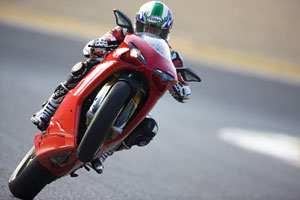
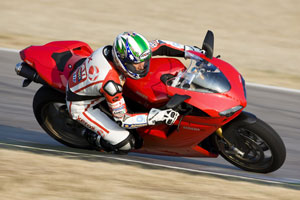
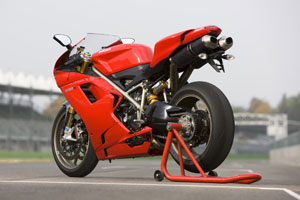
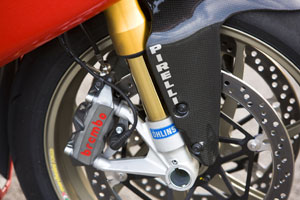
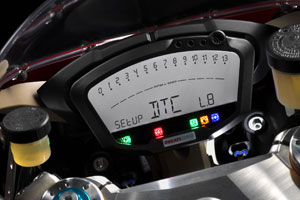
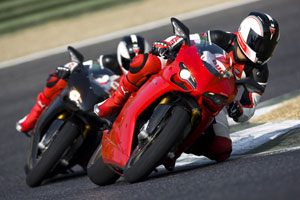
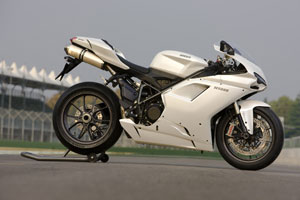





Newsletter